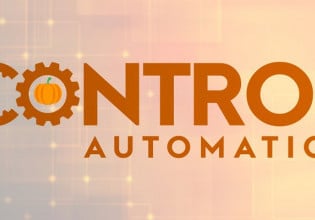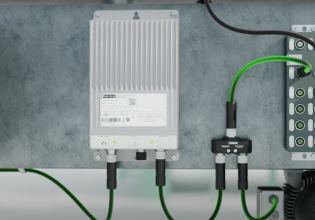Programmable Logic Controller (PLC) Considerations for Robot Cells
Programming, price, and safety are usually top considerations when choosing a PLC for a small robot cell. But how do each of these key considerations reflect in the day-to-day life of a control engineer?
Using Programmable Logic Controllers (PLCs) for Robot Cells
Robot cells often require a controller to run parts of the cell not generally in the robot’s scope of work. A controller, usually a programmable logic controller (PLC), controls axillary doors, clamps, safety, or anything else that an engineer may need for a fully autonomous cell.
Ladder logic programming is similar to wiring diagrams to keep the conversion from the wiring diagram to the functioning program simple. Ladder logic programming runs sequentially, making it possible for certain tasks to be completed through a chain of commands in the cell. They are also widely utilized for the safety systems in a cell. They can be programmed to stop every task in the cell as soon as the safety parameters in the cell are broken.
Robots generally use a C programming language and can be used similarly to a PLC with safety and I/O. Robots, however, are limited in the amount of I/O they can handle, and their safety systems are often not capable of keeping up with a cell containing a large amount of safety or I/O.
When the cell requires a PLC—either a larger cell or a cell with more complex external systems—there are many different types to choose from. The robot may have enough capability to control the entire set up on a smaller, simple cell, and an external PLC is unnecessary to control the cell properly. In this case, a robotic cell system without a PLC is often much cheaper. PLCs can be remarkably simple controllers capable of smaller amounts of I/O and safety, or they can control huge amounts of external systems, motors, conveyors, safety, palletizing, etc.
The price of a PLC is directly related to its capabilities. Brand names are also a determining factor in the cost of a controller. Certain brands cost more because they may offer more support, a longer warranty, or more durability in a manufacturing environment. So, let’s dive into how to choose the right PLC for a robot cell.
How to Choose a Programmable Logic Controller (PLC) for a Robot Cell
When it comes to varieties of small cell controllers, the sky’s the limit. Small, simple controllers that monitor and complete simple tasks can be found priced at a few hundred dollars. On the other end of the spectrum, some PLCs can run several tasks at once, take care of the safety system, and run a large number of inputs and outputs. These controllers will be priced well above several hundred dollars.
Figure 1. Various robot controllers from KUKA. Image used courtesy of KUKA
The complexity of the small robot cell is a good indicator of whether a simple controller can be used or if a more complex PLC is necessary. If the manufacturer plans on upgrading the cell in the future, or if there is any reason it might need more inputs and outputs, it is best to use a controller with more capacity than anticipated. An oversized controller allows for more flexibility within the cell long-term, thus accommodating any changes, such as adding sensors and I/O to the system.
Different brands of PLCs require different software programs, something to consider when choosing the right controller. For example, Allen-Bradley PLCs are programmed using proprietary software unique to Allen-Bradley controllers.
Allen-Bradley and other high-end PLC manufacturers require licensing and specially-trained programmers to use their software. Less expensive PLCs, like one from Automation Direct, are far more accessible and offer free software programs. However, a cheaper PLC may not offer an extensive technical support system like the more expensive brands. Price often, but not always, dictates the durability of the PLC. Suppose the cell operates in a harsh environment. In that case, it may be best to choose a more expensive controller for the sake of durability due to the physical demand imposed on the electronic components.
Other than price, software, and durability, there are other considerations when choosing the right PLC for a robot cell.
Robot Safety Systems and Other Considerations
All robotic cells need a safety system regardless of size or environment to protect operators and other employees in the plant. In some instances, the robot controller can maintain the safety systems in the cell. However, if cell safety requires much more than a pair of light curtains, the cell will require a standalone safety system.
Figure 2. A diagram showing how a robot controller interacts with other controllers. Image used courtesy of Ericsson
This generally consists of a safety-rated relay connected to a PLC or a PLC with an integrated safety system. When considering safety system options, it is best to compare the price difference between a PLC in tandem with safety relays and a PLC with safety integrated because the cost difference all depends on the cell’s specifications.
Most plants prefer certain brands for their automation needs to ensure uniformity throughout their automation. Brand preference reduces costs by encouraging uniformity among technicians and maintenance programming, which will likely offset the savings of choosing cheaper PLC. If dissatisfied with the current control system, consider reasons why and then search for a PLC that better suits the needs of the cell.
There are many things to consider when looking at a controller to accompany a small robotic cell. Oftentimes, a controller with a cheap purchase price may end up costing more than the difference in the price of downtime for maintenance and lack of support for the controller. If there is a lack of experience with a different brand’s programming, the learning curve may be nonsensical. Some robotic cells may not even require a separate controller if simple enough; but, if not, a controller can add efficiency and safety where necessary. Safety, complexity, product support, and brand familiarity should all be considered before choosing a specific controller.








